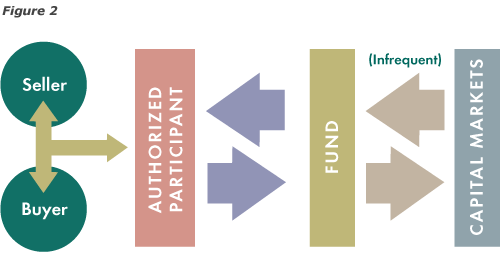Do you know the trading differences between mutual funds and ETFs
Post on: 5 Август, 2015 No Comment

Do you know the trading differences between mutual funds and ETFs?
Mutual funds and exchange-traded funds (ETFs) are two common types of investments. Both can offer investors a low-cost, liquid, and transparent way to build a diversified portfolio. Essentially, both fund types are baskets of investments – holding hundreds or thousands of securities – that can be accessed easily. However, the way in which they are accessed differs. Let’s take a closer look at some of the trading mechanics of these two investments.
Mutual funds trade once a day. All buy and sell orders flow in during the trading day, and are executed after market close. Each mutual fund determines its Net Asset Value (NAV), or its price per share. This price is based on the total value of the mutual fund’s holdings and is the price investors pay. Essentially, investors pay exactly what the underlying assets are worth at the close of the trading day.
On the other hand, ETFs trade throughout the day, just like individual stocks. This means that you can observe an ETF’s price changes continuously. However, as the ETF’s price fluctuates over the course of the day, it doesn’t necessarily reflect the value of its total underlying holdings, as does the day-end price of a mutual fund. Why is this?
An ETF’s price is influenced by daily market supply and demand forces, which can create imbalances. Often, the difference between the price and the value of the underlying holdings tends to be small, but this difference can become more pronounced during volatile market sessions. Investors are able to sell their ETFs immediately with the click of a mouse, but the actual holdings within the ETF can be harder to sell right away, especially when the holdings, like high-yield bonds, are less liquid. As a result, the ETF’s price can decline at a faster rate than those of its individual holdings. The same can hold true for the reverse scenario. When there is upside volatility, the ETF’s price can lag the collective value of its individual holdings. How is this a problem?
We don’t have to go far back in history to see this kind of mismatch. Consider the bond market sell-off in May of 2013. Bond prices came under significant stress as the Federal Reserve (the “Fed”) introduced its “taper talk” – in other words, the Fed announced that it would begin trimming its monthly bond purchases. As a result, investors worried that demand for high-yield bonds would fall, and prices declined as investors rushed for the exits, triggering massive outflows from high-yield bond ETFs. Investors who owned high-yield bond ETFs could sell immediately, but in most instances, at a significant discount (below the NAV). This type of scenario doesn’t occur with mutual funds as they trade once a day only.
The bottom line? It’s important to understand the trading mechanics of your investments. Mutual funds are priced once daily to reflect their underlying holdings fully. ETFs trade throughout the day, which can result in the buy/sell price not accurately reflecting the value of the ETF’s individual holdings.
Want to discuss the trading mechanics of your investment portfolio holdings? Contact a Wealth Management Advisor today at 800.898.4642.
Source: Investment Company Institute














